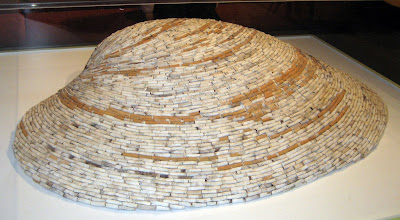White Shell Wednesday - What is this made from?
Can you see it? What is this hard clam shell made from? If you look closely, you will find that it is constructed entirely of tossed away cigarette butts. This huge, hard clam was part of the Trash to Treasure exhibit at the Maritime (Endicott Peabody) Museum in Salem, Massachusetts. One of their side exhibits offered sculptures made from recycled items and trash. This clam shell was almost 5 feet by 5 feet by 2 feet and was constructed entirely of tossed away cigarette butts. (first two photos will enlarge if you click on them)
 The detail is amazing.
The detail is amazing.
The likeness of the hard clam was spot on.

The common hard clam, also known as a quahog (or quahaug), round clam, or simply chowder clam is an edible mollusk which is native to the eastern shores of North America. It is one of many unrelated edible bivalves which in the USA are frequently referred to simply as clams.
Fishmarkets have specialty names for different sizes of this species of clam with the smallest clams called countnecks, next size up are littlenecks, then topnecks. Above that are the cherrystones, and the largest are called quahogs or chowder clams.
 In coastal areas of New England, raw bars specialize in serving littlenecks and topnecks raw on an opened half-shell. Littlenecks are often found in-the-shell in sauces, soups, stews, "clams casino" or substituted for European varieties such as the cockle in southern European seafood dishes. The largest clams, quahogs or chowders and cherrystones (with the toughest meat), are used in such dishes as clam chowder, clam cakes and stuffed clams.
In coastal areas of New England, raw bars specialize in serving littlenecks and topnecks raw on an opened half-shell. Littlenecks are often found in-the-shell in sauces, soups, stews, "clams casino" or substituted for European varieties such as the cockle in southern European seafood dishes. The largest clams, quahogs or chowders and cherrystones (with the toughest meat), are used in such dishes as clam chowder, clam cakes and stuffed clams.
Thick, rich and creamy, clam chowder is stick to the ribs, home cooking and this bowl of local clam chowder was thick enough to stand a spoon in the middle of it and on the cold, damp day I ordered it, warmed the "cockles of my heart".
 So this was an unusual white shell Wednesday as it had a touch of "green." Sea Witch
So this was an unusual white shell Wednesday as it had a touch of "green." Sea Witch 